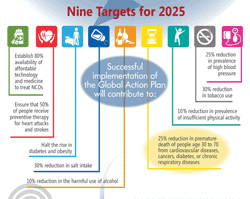Data and statistics

Body mass index (BMI)
BMI:
- is a simple index commonly used to classify overweight and obesity in schoolchildren and adults;
- is calculated as a person’s weight (in kg) divided by his or her height (in m2); and
- does not distinguish weight associated with muscle from weight associated with fat and therefore provides only a crude measure of fatness.
Overweight and obesity in adults
Overweight and obesity:
- are defined as abnormal or excessive fat accumulation that may impair health;
- have important consequences for morbidity, disability and quality of life;
- entail higher risk of developing type 2 diabetes, cardiovascular diseases, several common forms of cancer, osteoarthritis and other health problems; and
- are serious public health challenges in the WHO European Region.
WHO defines overweight in adults (aged over 19 years) as having a BMI equal to or greater than 25.0 kg/m2 and obesity as having a BMI equal to or greater than 30.0 kg/m2.
World wide, more than 1.4 billion adults aged 20 and older were overweight in 2008. Of these, over 200 million men and nearly 300 million women were obese. In the WHO European Region, the age-standardized prevalence of overweight was 58.3% among adult males and 51.2% among adult females.
Physical activity in adults
Excess weight gain only occurs when energy intake exceeds energy expenditure. Thus, a healthy body weight results from balancing regular physical activity and an adequate diet on a daily basis.
Physical activity means any bodily movement produced by skeletal muscles that requires energy expenditure. In 2008, around 35% of people aged 15 and over in the WHO European Region were insufficiently active.
Adults are physically active in the context of daily, family, and community life. Such activities include:
- recreation or leisure-time activity, such as play, games/sport or planned exercise;
- transportation (such as walking or cycling);
- occupational activity; and
- household chores.
Regular and adequate levels of physical activity in adults improve bone and functional health and reduce the risk of:
- hypertension
- cardiovascular diseases
- diabetes
- breast and colon cancer
- depression
- falls.



